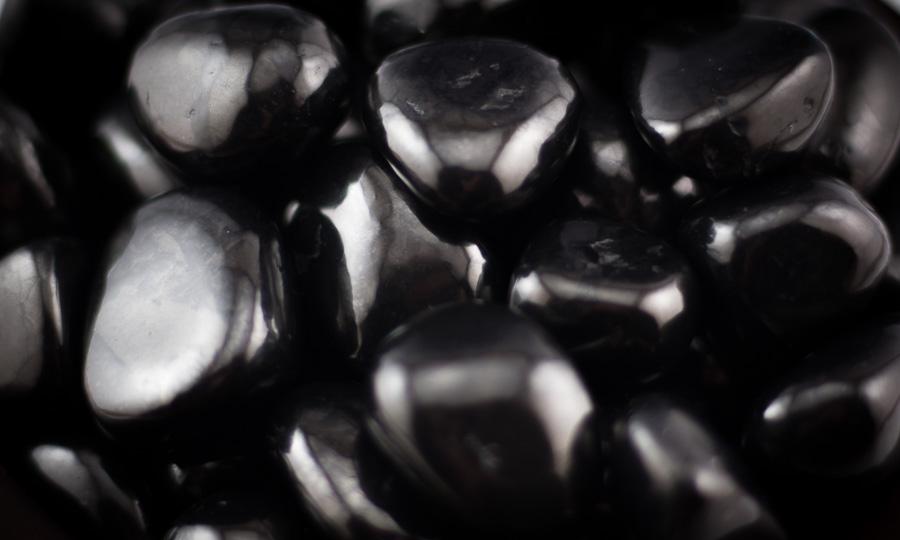You will not be allowed to compare more than 4 products at a time
View compareShungite Tumbled 1 lb
Shungite Tumbled 1 lb
Estimate delivery times:5-8 days.
Flat Rate Shipping and FREE Shipping on orders more than $100.
About This Product
Shungite – Ancient Guardian of Grounding & Purity
Appearance & Presence
Shungite emerges from the earth in shades of midnight black, a velvety darkness often streaked with subtle silvery inclusions that catch the light. In its raw state it tends toward a matte, charcoal-like sheen, but when polished it can gleam with a glassy, semi-metallic luster reminiscent of black obsidian. Some pieces reveal mirror-bright surfaces or pyrite veins, giving an almost cosmic sparkle against the coal-black background. The stone feels dense yet surprisingly smooth to the touch, emanating a strong energetic presence – as if one holds a fragment of Earth’s ancient night in hand. Visually and energetically, Shungite commands attention with its elemental beauty and palpable grounding force.
Historical & Cultural Significance
Shungite’s story is rooted in the remote forests of Karelia in northwestern Russia – the only place on Earth where this extraordinary stone is found. Named after the village of Shunga near its primary deposit, Shungite has been cherished in local folklore for centuries. Long before modern science took interest, the people of Karelia used Shungite to purify water, calling it a “stone of life” for its healing and cleansing abilities. Geologically, the stone itself is ancient – forming in Precambrian deposits estimated to be around 2 billion years old, which lends it a primordial mystique.
In the early 18th century, Peter the Great championed Shungite’s curative powers on a national stage. In 1714 he established Russia’s first medicinal spa, the Marcial Waters resort, in Karelia to leverage the region’s Shungite-infused spring waters. Bathing in and drinking these mineral-rich waters was believed to restore health and vitality. Peter the Great even ordered his soldiers to use Shungite-purified water to promote their well-being, and he incorporated the stone into the construction of his palaces. Such royal endorsement earned Shungite an almost legendary reputation in Russian history as a healing mineral. Though interest in Shungite quieted after the time of Peter, it never disappeared from local use. In the 20th century, scientists rediscovered Shungite’s unique properties – notably identifying hollow carbon molecules called fullerenes within it – sparking renewed global interest. Today, Shungite enjoys a dual legacy: revered in wellness and spiritual communities for its age-old healing lore, and studied by researchers for its remarkable carbon chemistry and filtration abilities.
Metaphysical Symbolism & Energetic Qualities
Shungite carries a grounding, elemental energy that resonates strongly with the Root Chakra (Muladhara). Often described as a stone that cements one’s connection to the earth, it helps anchor scattered energy and promote inner stability. In meditation and healing work, Shungite’s deep black presence is thought to absorb excess or negative vibrations, allowing one to feel centered, safe, and rooted. This grounding quality can foster a sense of calm and balance – a reminder of the ancient earth beneath our feet. Many practitioners value Shungite for its ability to align the root chakra, infusing the body with nurturing Earth energy and a solid foundation of strength and support. By attuning to Shungite, one may tap into primordial wisdom and the comforting assurance of Mother Earth’s embrace.
Equally celebrated is Shungite’s powerful purifying and protective aura. Just as it purifies water in the physical realm, Shungite is believed to purify one’s energetic field – cleansing the aura of toxicity, stress, and negativity. Energy healers hail it as a natural shield: Shungite can absorb and neutralize electromagnetic frequencies (EMFs) and radiation from electronics, which is why it’s commonly placed near computers, Wi-Fi routers, and cell phones. In an age filled with electronic noise, Shungite stands as an EMF guardian, helping to dispel electro-smog and create a more harmonious space. On a spiritual level, it’s used as a protective talisman against psychic harm or unwanted energies. Many feel that keeping Shungite nearby is like surrounding oneself with an energetic forcefield – a black shield of ancient energy that blocks out darkness and restores balance. This stone’s symbolism weaves together themes of grounding, purification, and shielding, making it a favorite for those seeking both deep earth connection and vigilant energetic protection.
Decorative & Luxury Appeal
Beyond its healing and scientific intrigue, Shungite has an undeniable aesthetic allure that appeals to collectors, designers, and luxury enthusiasts alike. Its lustrous onyx-black color and occasional metallic flashes give it a dramatic, elegant look. Artisans often polish Shungite to a mirror shine or carve it into geometric shapes, creating pieces that are both visually striking and spiritually meaningful. Whether displayed as a natural fragment or a polished object, Shungite exudes a minimalist modern beauty that complements any setting – all while emanating an aura of mystery and antiquity. Here are some of the ways Shungite graces homes, offices, and personal style:
-
Raw Stones: Unrefined Shungite chunks or plates are used as rustic décor or healing tools. Their organic form highlights the stone’s natural matte-black texture with occasional fool’s gold sparkles of pyrite. Many place raw Shungite by electronics or in water carafes for its earthy charm and purifying function.
-
Polished Spheres: Smooth Shungite spheres, shining like black mirrors, serve as both art pieces and energy balancers. A sphere radiates energy evenly in all directions, and a Shungite globe on a stand becomes a bold accent that is said to harmonize a room’s energy while looking sleek and luxurious.
-
Pyramids & Cones: Shungite carved into pyramids is especially popular. These geometric forms are not only modern sculptural accents but are also believed to amplify Shungite’s protective field – a 3D embodiment of sacred geometry and ancient architecture. A Shungite pyramid on a desk or nightstand is often used to mitigate EMFs and is an eye-catching conversation piece.
-
EMF Plates & Tiles: Thin, flat pieces of Shungite are crafted into discs, tiles, or phone charms that can be attached to electronics. These polished black plates add a subtle touch of sophistication to devices or workspaces, and they’re marketed for those seeking EMF reduction in a stylish form.
-
Tumbled Stones & Jewelry: Small Shungite pebbles are tumbled to a glossy finish, resulting in pebble-like gems that can be carried in the pocket or placed in a bowl. Jewelers incorporate Shungite beads and cabochons into bracelets, necklaces, and rings, where the stone’s neutral black tone pairs elegantly with metals like silver or gold. Wearing Shungite is both a fashion statement and a personal shield of protective energy.
-
Carvings & Sacred Geometry: Skilled artisans carve Shungite into figurines, obelisks, cubes, or sacred geometry shapes (like spheres inscribed with symbols, Merkaba stars, etc.). These pieces cater to luxury collectors and spiritual practitioners, merging art with metaphysics. A Shungite Merkaba or an engraved plate (for example, etched with the Flower of Life or Metatron’s Cube) combines the stone’s grounding force with iconic symbols, creating high-vibration décor for altars or living spaces.
In all these forms, Shungite brings a touch of luxurious mystique. Its jet-black color offers a bold accent in modern design, while its reputation as an ancient healing stone adds depth and story to each piece. Whether used for its perceived energetic benefits or purely for its striking look, Shungite has secured a place as both a holistic wellness tool and a sophisticated decorative element in contemporary life.
Scientific Properties & Identification
Shungite is not just spiritually significant – it boasts very distinct scientific characteristics that set it apart from other stones. Below is a full breakdown of Shungite’s physical and chemical profile, which contributes to its unique abilities and appearance:
-
Chemical Composition: Shungite is a carbon-rich metamorphic rock composed primarily of carbon (C). Depending on the grade, it can contain anywhere from about 30% up to ~98% carbon by weight. The highest-grade Shungite (often called Type I or “elite/noble” Shungite) has the most carbon (over 90% and approaching 98%) and a shiny, silvery-black appearance. Lower grades include more impurities like silica and trace minerals (such as quartz, pyrite, alumina, iron, etc.), giving them a duller look and lower carbon content. This carbon is arranged not in a single crystal lattice, but as a complex mix of forms, including unique hollow molecules called fullerenes (spherical carbon cages) embedded within the stone. These fullerenes – famously C60 and C70 buckyballs – have attracted scientific interest for their antioxidant and adsorptive properties, and Shungite is one of the only known natural sources of them.
-
Crystal System: None (Amorphous). Shungite is classified as a mineraloid, meaning it lacks a defined crystalline structure. Unlike true minerals, it does not form regular crystals. Its carbon is non-graphitized and largely amorphous, similar to the structure of glass or coal. Microscopically, Shungite may have a cryptocrystalline texture (tiny particles) but no repeating lattice. This amorphous nature is why Shungite can break with smooth, curved surfaces despite not having cleavage planes.
-
Hardness: 3.5 to 4 on the Mohs scale. Shungite is relatively soft compared to quartz or diamond, but a bit harder than pure graphite. Higher-carbon Shungite tends to be slightly more brittle; it can be scratched with a knife or steel file. This moderate hardness means Shungite can be carved or polished easily, but very high-grade (98% carbon) pieces can be fragile and may flake if handled roughly.
-
Luster: Dull matte to semi-metallic (sometimes described as vitreous or oily sheen). Unpolished Shungite often has a matte, charcoal-like luster. When polished or in its elite form, it develops a brilliant metallic shine or glassy glow. Elite Shungite’s surfaces can appear silvery-black and reflective, whereas common Shungite is more satiny or silky in gloss. This variability in luster corresponds to the carbon content and smoothness of the surface.
-
Color & Transparency: Black (occasionally ranging to dark gray or steel-silver in high-grade pieces) and completely opaque. No light will pass through Shungite, even in thin slivers, due to its carbon density. Some specimens show brown or bronze tints if mixed with certain minerals, but pure Shungite is jet black. It may also exhibit veins or patches of other minerals – for example, pale veins of quartz or shiny specks of pyrite (fool’s gold) are common in genuine Shungite. These inclusions can create contrast in the black matrix, but do not diminish the stone’s opacity.
-
Cleavage & Fracture: Cleavage: None. Shungite does not break along any neat planar cleavage, because it has no crystalline arrangement to dictate such planes. Fracture: Conchoidal (smooth, curved fracture surfaces). When Shungite is broken or knapped, it often chips like glass or obsidian, forming shell-like curved surfaces with sharp edges. This conchoidal fracture is another giveaway of its amorphous nature. Lower-grade Shungite with more impurities might break more irregularly, but generally you’ll see rounded glossy fracture facets on fresh breaks.
-
Streak: Black. Rubbing Shungite on a porcelain streak plate (or even paper) leaves a sooty black streak. In fact, genuine Shungite may leave a faint black residue on fingers or surfaces, especially when unpolished – a result of its high carbon content (similar to touching coal or pencil graphite). This residue is normal and washes off, and is even used industrially (Shungite was historically used as a black pigment for paint). The streak test is a handy way to identify Shungite and distinguish it from look-alikes, which might have a lighter streak.
-
Density: 1.9 – 2.3 (Specific Gravity). Shungite is moderately lightweight for a “stone” due to its carbon richness. It is denser than wood or charcoal, but lighter than most rocks like quartz or metal ores. A piece of Shungite might feel a bit “light” in the hand compared to an equally sized piece of pure metal or crystal. This relatively low density, combined with its black color and carbon content, sometimes leads people to compare it to coal, though Shungite is harder and more compact.
-
Electrical Conductivity: Highly conductive. Unusual for a rock, Shungite can conduct electricity because of its carbon (especially the graphitic microstructures within). In fact, a common demonstration of authentic Shungite is to use it to close a circuit – a flashlight bulb or LED can be lit by touching wires to a Shungite stone, confirming its conductive nature. This property underpins its popular use in EMF shielding devices and is one reason it’s studied for industrial applications (like in paints or electrodes). Do note that the highest-carbon Shungite conducts best; pieces with more impurities or lower carbon content might be less conductive.
-
Unique Features: Shungite’s most famous scientific feature is the presence of fullerenes – spherical carbon molecules discovered in the stone in the 1990s. These molecules (nicknamed “buckyballs”) have known antioxidant properties and have been researched for potential medical and technological uses. Beyond fullerenes, Shungite acts as a natural adsorbent: it can absorb and neutralize contaminants. This explains its historic use in water purification – it removes bacteria and organic impurities, and can even eliminate odors or taste from water. Modern studies have investigated Shungite for filtering heavy metals and chemicals from water, attributing this to its porous carbon structure and chemical affinity for pollutants. Additionally, some Shungite exhibits weak magnetism (if it contains traces of magnetic minerals), though this is not a consistent feature. Another curious aspect is that Shungite contains virtually every mineral in the periodic table in trace amounts (a fact often cited from Russian research), which poetically suggests it carries a little “essence” of many Earth elements.
-
Primary Source: Karelia, Russia – specifically the Shungá (Shunga) and Zazhoginsky deposits near Lake Onega. All authentic Shungite on the market hails from this remote northern region of Russia. The Zazhoginskoye deposit is the largest and most well-known, providing Shungite for commercial use for centuries. These deposits were formed eons ago in ancient mud swamps or seabeds that transformed under geological processes into the carbon-rich rock we now call Shungite. While minor occurrences of similar carbonaceous rocks have been noted elsewhere, none match the purity and concentration of the Karelian Shungite. This exclusivity adds to Shungite’s value and mystique. When purchasing Shungite, reputable suppliers will often certify its Karelian origin, as the name itself is protected by its regional heritage.
-
Identifying Traits: Genuine Shungite is characterized by its jet-black color, soft sooty streak, and occasional metallic inclusions. It is entirely opaque and often gives off a conductive, “cool” feeling against the skin. If you scratch or rub it, it might leave a charcoal-like mark (especially unpolished pieces) – this is a quick identity check. Shungite’s surface may appear matte with dull waxy shine, or highly reflective if polished. Importantly, many Shungite pieces will display tiny golden or silvery specks; these are typically pyrite or other mineral inclusions and are a good sign of authenticity. The combination of black carbon matrix with these glimmering flecks is visually unique. Finally, you can test Shungite with a multimeter or simple battery circuit – true Shungite will conduct electricity, unlike most black imitation stones. All these traits together – the ancient carbon content, the black color, the lustrous shine when polished, the conductive nature, and the singular source in Russia – make Shungite a one-of-a-kind gemstone of both scientific and metaphysical distinction.
Conclusion
In summary, Shungite stands at the rare intersection of legend and science, earth and element, luxury and healing. Its deep black presence speaks of the earth’s origin and stability, while its shimmering hints of silver whisper of cosmic wonders within. For spiritual healers and energy workers, Shungite is a grounding cornerstone – a purifier that shields and transforms negativity into light. For scientists and holistic health enthusiasts, it is a fascinating natural filter and antioxidant source, proving that nature’s alchemy can surpass our own. For collectors and lovers of fine décor, Shungite offers an empowering statement piece – ancient, elegant, and enduring.
Holding a piece of Shungite, one can feel the convergence of ancient Earth energy and modern purpose. It is at once a relic of the primordial world and a tool for contemporary well-being. Mysterious yet approachable, Shungite invites us to experience protection, grounding, and rejuvenation in a tangible form. Whether you are drawn to it for its mystical aura, its protective properties, or its refined beauty, Shungite remains a testament to the power of the Earth – a guardian stone that has patiently waited through the ages to share its grounding, elemental, and empowering energy with us.
Sub total:
$45.49





 $16.49
$16.49 $48.49
$48.49